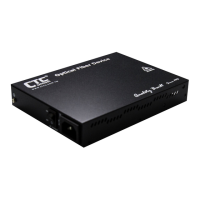3.1.6 QinQ VLAN Configuration
<< Q in Q Status and Configuration >>
<1> Q in Q Active [ Disable ]
<2> Q in Q Tag Priority [ Internal ]
<3> Q in Q Direction [ TP add tag ,FX Remove tag ]
<4> Q in Q Tag ID [ 0x8100 ]
<5> Q in Q VID Tag [ 1 ]
Q in Q or double VLAN tagging is defined in IEEE802.1ad. Double VLAN tagging is required when a service provider wishes to carry a
customer’s VLAN tagged traffic through its own VLAN network. In MEF (Metro Ethernet Forum) terms, the first tag or “inner tag” is referred to
as the C-tag (customer) while the second tag or “outer tag” is referred to as the S-tag (service provider). Normal VLAN tag has an EtherType
(TPID or Tag Protocol Identifier) of 0x8100. The IEEE802.1ad standard recommends 0x88a8 TPID for the outer or S-tag.
Q in Q Active is used to enable or disable the double tagging function. Q in Q Tag Priority provides the QoS method. When selecting
‘Internal’ priority, the three bit VLAN tag priority bits are mapped to the internal 2-bit priority. When selecting ‘Remark’ 802.1P remarking QOS
will be used instead.
Q in Q Direction sets up how the tagging is carried from provider to customer. If this were a CPE device with fiber facing the service
provider, we would want to configure the FX add tag ,TP Remove tag option. i.e., add the outer tag heading towards service provider (out
fiber) and remove the S-tag at customer side (out TP).
Q in Q Tag ID is what IEEE802.1ad refers to as TPID (Tag Protocol Identifier) or what is also referred to as the EtherType. These 2 octets
follow the S-tag and C-tag in the Ethernet frame. Finally, the Q in Q VID Tag assigns the actual value to the S-tag from the range of 1~4094.
Example of S-tag with VID 999 configured at customer side device.
<< Q in Q Status and Configuration >>
<1> Q in Q Active [ Enable ]
<2> Q in Q Tag Priority [ Internal ]
<3> Q in Q Direction [ FX add tag ,TP Remove tag ]
<4> Q in Q Tag ID [ 0x88a8 ]
<5> Q in Q VID Tag [ 999 ]
20

